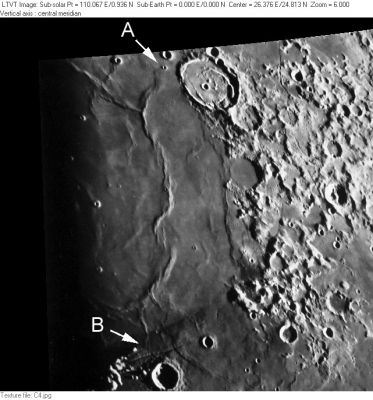Serpentine Ridge
Contents
Serpentine Ridge
(informal name)
|
Lat: 25°N, Long: 25°E, Length: 500 km, Height: km, Rükl: 24 |

Consolidated Lunar Atlas plate C4 The "Serpentine Ridge" is the long series of mare ridges extending from "A" to "B".
Images
LPOD Photo Gallery Lunar Orbiter Images Apollo Images
- The Serpentine Ridge (Dorsa Smirnov) was frequently photographed during the missions of Apollo 15 and Apollo 17. - DannyCaes Apr 30, 2010
Maps
(LAC zone 42B3) LAC map Geologic map LM map
Description
Description: Elger
(IAU Directions) Mare Serenitatis ... includes besides one of the longest and loftiest (ridges) on the moon's visible surface -- the great serpentine ridge, first drawn and described nearly a hundred years ago by the famous selenographer, Schroter of Lilienthal. Originating at a little crater under the north-west wall of great ring-plain Posidonius, it follows a winding course across the Mare toward the south, throwing out many minor branches, and ultimately dies out under a great rocky promontory--the Promontory Acherusia, at the eastern termination of the Haemus range. A comparatively low power serves to show the curious structural character of this immense ridge, which appears to consist of a number of corrugations and folds massed together, rising in places, according to Neison, to a height of 700 feet and more.
Additional Information
Nomenclature
- Drawn by Johann Schröter (Whitaker, Fig. 67, p. 104 -- Schröter's Plate X, observed on November 17, 1789 at 10:10 pm local time). On page 185 of the first volume of his book, Schröter refers to the ridge as a "fortlaufende Bergader" ("fortlaufende" = continuous; "Berg" = mountain; "Ader" = vein, as in coal mining) connecting Plinius and Posidonius. At the bottom of the page he further describes it as "schlangenformig" ("schlangen" = snake/serpent).
- Thanks to - wilfried_tost for help with the translations (- JimMosher)
- Various English observer's picked up on Schröter's descriptive term. For example, on page 180 of an 1868 edition of the Astronomical register, Birt refers to "the well-known serpentine ridge of Schröter." However, like ""Bergader", the term "serpentine" was also used with some indifference as a descriptive term. For example, in various publications Elger refers to "the great Serpentine ridge", but there is little other than the extra adjective "great" to distinguish this from Elger's serpentine ridges in Mare Frigoris and near Langrenus.
- Although this feature was drawn on the maps of Blagg and Müller, it was not named by them. Several features along it did have IAU-approved names: Posidonius Gamma (the elevated region around Posidonius Y -- regarded as a "crater cone"), the crater Very (Le Monnier B), and Bessel Alpha (an elevated point to the south of Very which no longer has an official name).
- In the modern IAU nomenclature, the Serpentine Ridge corresponds to Dorsum Nicol, portions of Dorsa Lister, Dorsa Smirnov, and an unnamed northward extension of that ridge ending near Posidonius F.
LPOD Articles
Bibliography